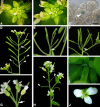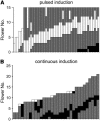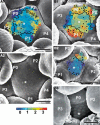Dynamic and compensatory responses of Arabidopsis shoot and floral meristems to CLV3 signaling
- PMID: 16603652
- PMCID: PMC1456859
- DOI: 10.1105/tpc.105.040444
Dynamic and compensatory responses of Arabidopsis shoot and floral meristems to CLV3 signaling
Abstract
In Arabidopsis thaliana, the stem cell population of the shoot system is controlled by regulatory circuitry involving the WUSCHEL (WUS) and CLAVATA (CLV1-3) genes. WUS signals from the organizing center (OC) to promote stem cell fate at the meristem apex. Stem cells express the secreted peptide CLV3 that activates a signal transduction cascade to restrict WUS expression, thus providing a feedback mechanism. Stem cell homeostasis is proposed to be achieved by balancing these signals. We tested the dynamics of CLV3 signaling using an inducible gene expression system. We show here that increasing the CLV3 signal can very rapidly repress WUS expression during development, which in turn causes a fast reduction of CLV3 expression. We demonstrate that increased CLV3 signaling restricts meristem growth and promotes allocation of peripheral meristem cells into organ primordia. In addition, we extend the current model for stem cell control by showing that meristem homeostasis tolerates variation in CLV3 levels over a 10-fold range and that high-level CLV3 signaling can be partially compensated with time, indicating that the level of CLV3 expression communicates only limited information on stem cell number to the underlying OC cells.
Figures







References
-
- Baurle, I., and Laux, T. (2003). Apical meristems: The plant's fountain of youth. Bioessays 25 961–970. - PubMed
-
- Bechtold, N., and Pelletier, G. (1998). In planta Agrobacterium-mediated transformation of adult Arabidopsis thaliana plants by vacuum infiltration. Methods Mol. Biol. 82 259–266. - PubMed
-
- Becker, D., Kemper, E., Schell, J., and Masterson, R. (1992). New plant binary vectors with selectable markers located proximal to the left T-DNA border. Plant Mol. Biol. 20 1195–1197. - PubMed
-
- Brand, U., Fletcher, J.C., Hobe, M., Meyerowitz, E.M., and Simon, R. (2000). Dependence of stem cell fate in Arabidopsis on a feedback loop regulated by CLV3 activity. Science 289 617–619. - PubMed
Publication types
MeSH terms
Substances
LinkOut - more resources
Full Text Sources
Other Literature Sources
Molecular Biology Databases
Miscellaneous

